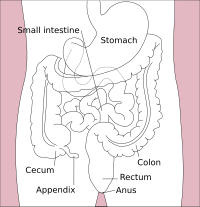| Jejunum | |
|---|---|
 Small intestine | |
 Superior and inferior duodenal fossæ. | |
| Details | |
| Pronunciation | /dʒɪˈdʒuːnəm/ jij-OO-nəm[2][3] |
| Precursor | Midgut |
| Part of | Small intestine |
| System | Digestive system |
| Artery | Jejunal arteries |
| Vein | Jejunal veins |
| Nerve | Celiac ganglia, vagus[1] |
| Identifiers | |
| Latin | jejunum |
| MeSH | D007583 |
| TA98 | A05.6.03.001 |
| TA2 | 2958 |
| FMA | 7207 |
| Anatomical terminology | |
 |
| Major parts of the |
| Gastrointestinal tract |
|---|
The jejunum is the second part of the small intestine in humans and most higher vertebrates, including mammals, reptiles, and birds. Its lining is specialized for the absorption by enterocytes of small nutrient molecules which have been previously digested by enzymes in the duodenum.
The jejunum lies between the duodenum and the ileum and is considered to start at the suspensory muscle of the duodenum, a location called the duodenojejunal flexure.[4] The division between the jejunum and ileum is not anatomically distinct.[5] In adult humans, the small intestine is usually 6–7 m (20–23 ft) long (post mortem), about two-fifths of which (about 2.5 m (8.2 ft)) is the jejunum.[4]
- ^ Nosek, Thomas M. "Section 6/6ch2/s6ch2_30". Essentials of Human Physiology. Archived from the original on 2016-03-24.
- ^ OED 2nd edition, 1989.
- ^ Entry "jejunum" in Merriam-Webster Online Dictionary.
- ^ a b Drake, Richard L.; Vogl, Wayne; Tibbitts, Adam W. M. Mitchell; illustrations by Richard; Richardson, Paul (2005). Gray's anatomy for students. Philadelphia: Elsevier/Churchill Livingstone. pp. 273–275. ISBN 978-0-8089-2306-0.
- ^ Deakin, Barbara Young; et al. (2006). Wheater's functional histology : a text and colour atlas (5th ed.). Churchill Livingstone/Elsevier. p. 263. ISBN 978-0-443-068-508.